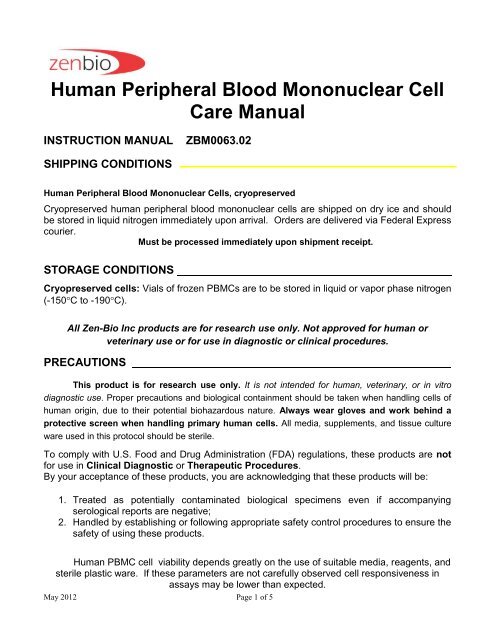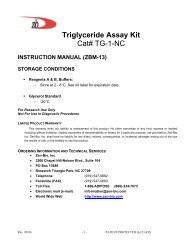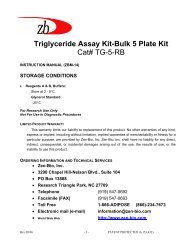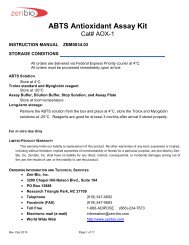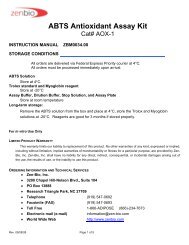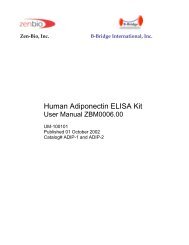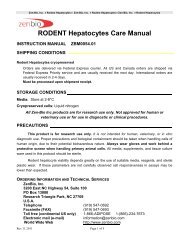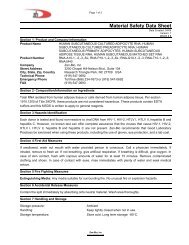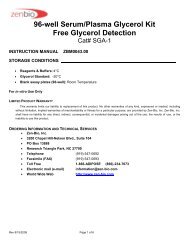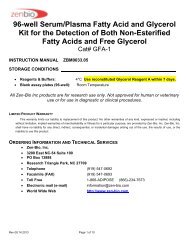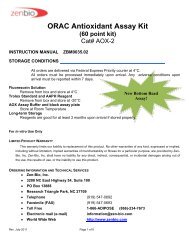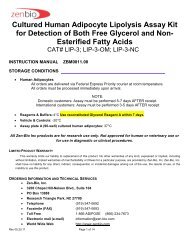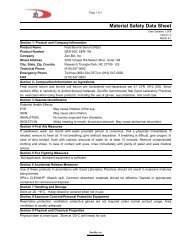Human Peripheral Blood Mononuclear Cell Care ... - Zen-Bio Inc.
Human Peripheral Blood Mononuclear Cell Care ... - Zen-Bio Inc.
Human Peripheral Blood Mononuclear Cell Care ... - Zen-Bio Inc.
You also want an ePaper? Increase the reach of your titles
YUMPU automatically turns print PDFs into web optimized ePapers that Google loves.
<strong>Human</strong> <strong>Peripheral</strong> <strong>Blood</strong> <strong>Mononuclear</strong> <strong>Cell</strong><br />
<strong>Care</strong> Manual<br />
INSTRUCTION MANUAL<br />
ZBM0063.02<br />
SHIPPING CONDITIONS<br />
<strong>Human</strong> <strong>Peripheral</strong> <strong>Blood</strong> <strong>Mononuclear</strong> <strong>Cell</strong>s, cryopreserved<br />
Cryopreserved human peripheral blood mononuclear cells are shipped on dry ice and should<br />
be stored in liquid nitrogen immediately upon arrival. Orders are delivered via Federal Express<br />
courier.<br />
Must be processed immediately upon shipment receipt.<br />
STORAGE CONDITIONS<br />
Cryopreserved cells: Vials of frozen PBMCs are to be stored in liquid or vapor phase nitrogen<br />
(-150C to -190C).<br />
All <strong>Zen</strong>-<strong>Bio</strong> <strong>Inc</strong> products are for research use only. Not approved for human or<br />
veterinary use or for use in diagnostic or clinical procedures.<br />
PRECAUTIONS<br />
This product is for research use only. It is not intended for human, veterinary, or in vitro<br />
diagnostic use. Proper precautions and biological containment should be taken when handling cells of<br />
human origin, due to their potential biohazardous nature. Always wear gloves and work behind a<br />
protective screen when handling primary human cells. All media, supplements, and tissue culture<br />
ware used in this protocol should be sterile.<br />
To comply with U.S. Food and Drug Administration (FDA) regulations, these products are not<br />
for use in Clinical Diagnostic or Therapeutic Procedures.<br />
By your acceptance of these products, you are acknowledging that these products will be:<br />
1. Treated as potentially contaminated biological specimens even if accompanying<br />
serological reports are negative;<br />
2. Handled by establishing or following appropriate safety control procedures to ensure the<br />
safety of using these products.<br />
<strong>Human</strong> PBMC cell viability depends greatly on the use of suitable media, reagents, and<br />
sterile plastic ware. If these parameters are not carefully observed cell responsiveness in<br />
assays may be lower than expected.<br />
May 2012 Page 1 of 5
ORDERING INFORMATION AND TECHNICAL SERVICES<br />
<strong>Zen</strong><strong>Bio</strong>, <strong>Inc</strong>.<br />
3200 Chapel Hill-Nelson Blvd., Suite 104<br />
PO Box 13888<br />
Research Triangle Park, NC 27709<br />
U.S.A.<br />
Telephone (919) 547-0692<br />
Facsimile (FAX) (919) 547-0693<br />
Toll free (continental US only) 1-866-ADIPOSE 1-(866)-234-7673<br />
Electronic mail (e-mail)<br />
information@zenbio.com<br />
World Wide Web<br />
http://www.zenbio.com<br />
INTRODUCTION<br />
A peripheral blood mononuclear cell (PBMC) is defined as any blood cell with a round<br />
nucleus (i.e. a lymphocyte, a monocyte, or a macrophage). These blood cells are a critical<br />
component in the immune system to fight infection and adapt to intruders. The lymphocyte<br />
population consists of CD4+ and CD8+ T cells, B cells and Natural Killer cells, CD14+<br />
Monocytes, and Basophils/Neutrophils/Eosinophils/Dendritic cells. These cells are often<br />
extracted from whole blood or from Leukopak using Ficoll, a hydrophilic polysaccharide that<br />
separates layers of blood, with monocytes and lymphocytes forming a buffy coat under a layer<br />
of plasma. This buffy coat contains the PBMCs. Additionally; PBMCs can be extracted from<br />
whole blood using a hypotonic lysis which will preferentially lyse red blood cells. This method<br />
results in neutrophils and other polymorphonuclear (PMN) cells, which are important in innate<br />
immune defense being obtained.<br />
May 2012 Page 2 of 5
QUALITY CONTROL<br />
Quality control tests are performed for each lot of <strong>Human</strong> <strong>Peripheral</strong> <strong>Blood</strong> <strong>Mononuclear</strong><br />
cells. The cells are characterized by their surface markers via flow cytometry. Population<br />
distributions expressed as percentage positive are presented on the certificate of analysis for<br />
each lot of cells. <strong>Cell</strong>s have a guaranteed purity of >95% and a viability >80%. In addition, all<br />
blood products have been tested for some common blood borne pathogens and microbial<br />
contaminants.<br />
INTENDED USE<br />
Cryopreserved <strong>Human</strong> <strong>Peripheral</strong> <strong>Blood</strong> <strong>Mononuclear</strong> <strong>Cell</strong>s (PBMCs) are available as<br />
positive and negative controls for T-cell monitoring in ELISPOT, ELISA, cytokine bead array,<br />
tetramer/pentamer, and flow cytometry assays. We do not provide protocols.<br />
MATERIALS PROVIDED FOR EACH CATALOG ITEM<br />
Cryopreserved human peripheral blood mononuclear cells<br />
Catalog # SER-PBMC<br />
Frozen vial containing 15 million cells/vial of peripheral blood mononuclear cells<br />
COMPOSITION OF OPTIONAL MEDIUM AVAILABLE _____________<br />
Lymphocyte Medium<br />
(Cat# Lymph-1)<br />
RPMI 1640<br />
Fetal Bovine Serum<br />
Hepes<br />
Penicillin<br />
Streptomycin<br />
Amphotericin B<br />
May 2012 Page 3 of 5
THAWING CRYOPRESERVED PERIPHERAL BLOOD<br />
MONONUCLEAR CELLS (PBMC)<br />
1. Warm Lymphocyte Medium (Cat # LYMPH-1) to 37°C.<br />
2. Rapidly thaw the vial of frozen cells in a 37C water bath until just prior to complete<br />
thawing (slurry of residual ice should be present). Wipe the outside of the vial with 70%<br />
ethanol.<br />
3. Aseptically transfer the cell suspension to a 50ml conical tube.<br />
4. Rinse the vial with 1 mL of medium. Then slowly add drop wise to the cells in the 50 ml<br />
conical tube while gently swirling the tube.<br />
5. Slowly add medium drop wise to the 50 mL tube until the total volume reaches 25 ml.<br />
6. Centrifuge the cell suspension at 200x g at room temperature for 15 minutes.<br />
7. <strong>Care</strong>fully remove the supernatant and save in a second tube leaving 1 mL behind as not<br />
to disturb the pellet.<br />
8. Gently resuspend the cells up to a volume of 2 mL (2 mL per vial of product). Count the<br />
number of cells. If count is lower than expected, centrifuge the wash that was saved at a<br />
higher speed, count and combine if necessary.<br />
9. Gently resuspend cells to desired concentration as per your protocol.<br />
FREQUENTLY ASKED QUESTIONS<br />
1. Do you test for pathogens? Which ones? Yes. Samples from each donor are tested<br />
via PCR to confirm non-reactivity for HIV-1, HIV-2, HTLV I, HTLV II, syphilis, CMV,<br />
hepatitis B and hepatitis C. However, since we cannot test all pathogens, please treat<br />
the culture as a potentially infectious agent at <strong>Bio</strong>safety Level 2 or higher.<br />
2. What donor information do I receive? The donor’s age, race, and gender are<br />
provided in the certificate of analysis that accompanies each lot of cells.<br />
3. Do you have any protocols for ways to use the cells? No. We do not provide any<br />
protocols for the use of the peripheral blood mononuclear cells. The uses for this<br />
product are too varied to provide a comprehensive protocol suitable for each<br />
experiment.<br />
May 2012 Page 4 of 5
PATHOGEN TESTING<br />
Samples from each donor are tested via PCR to confirm non-reactivity for HIV-1, HIV-2,<br />
HTLV I, HTLV II, syphilis, CMV, hepatitis B and hepatitis C. However, no known test can offer<br />
complete assurance that the cells are pathogen free. Our products are tested and are free<br />
from mycoplasma contamination. Proper precautions and biological containment should be<br />
taken when handling cells of human origin, due to their potential biohazardous nature. All<br />
human based products should be handled at a BSL-2 (<strong>Bio</strong>safety Level 2) or higher. Always<br />
wear gloves and work behind a protective screen when handling primary human cells.<br />
May 2012 Page 5 of 5


